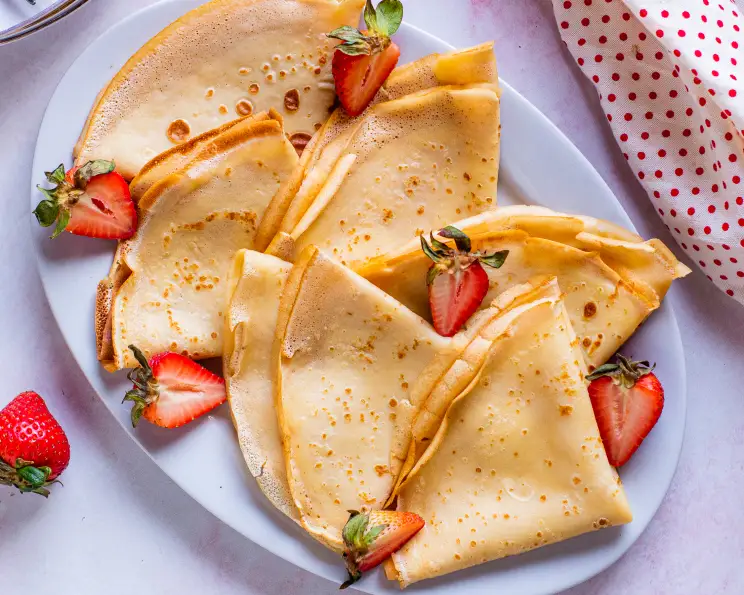Creating the perfect crepe is an art form that combines simple ingredients and technique to produce a versatile dish that can be enjoyed at any time. Whether you’re seeking a sweet treat or a savory meal, learning how to make crepes will add a sophisticated touch to your culinary repertoire. This comprehensive guide will take you through every step of the process, ensuring that you learn the skills needed to make delicious crepes from the comfort of your home.
Understanding the Basics of Crepes
Crepes are a type of very thin pancake originated from France, typically made from wheat flour or buckwheat flour. The principal difference between a pancake and a crepe is the consistency and thickness of the batter; crepe batter is much thinner, creating a paper-thin and flexible finished product that can be rolled or folded with various fillings. The versatility of crepes allows them to be paired with an array of ingredients, making them suitable for breakfast, lunch, dinner, or dessert.
The essential ingredients in crepe batter include flour, milk, eggs, and a pinch of salt. These components are mixed to create a fluid, smooth batter that cooks quickly on a hot skillet or crepe maker. The technique in spreading the batter and controlling the temperature plays a pivotal role in achieving the perfect texture and color. A well-made crepe should be lightly golden, with a subtle elasticity to allow for easy folding and wrapping around fillings.
One key to mastering crepe making is ensuring the batter is free of lumps and has the consistency of heavy cream. Many chefs recommend resting the batter for at least an hour, which allows the flour to hydrate and the gluten to relax, resulting in tender crepes. Adjustments may be needed based on the type of flour used and environmental factors such as humidity and altitude, which can affect the batter’s behavior.
Step-by-Step Guide to Making Crepes
Ingredients and Tools Needed
To start your journey to becoming a crepe connoisseur, you’ll need the following ingredients: all-purpose flour, eggs, milk (dairy or non-dairy alternatives), water, salt, and butter (for cooking). Optional ingredients include sugar for sweet crepes or herbs and spices for savory versions. The basic tools required include a mixing bowl, a whisk or blender, a 10 to 12-inch non-stick skillet or crepe maker, and a spatula.
Begin by mixing the flour and salt in a bowl. In a separate bowl, beat the eggs, then add the milk and water, ensuring these liquids are well combined. Gradually add the liquid mixture to the dry ingredients while continuously whisking to avoid lumps. Once the batter is smooth, stir in melted butter. This process can also be done using a blender, which often results in an even smoother batter. Let the batter rest in the refrigerator to enhance the texture of your crepes.
Heat your skillet or crepe maker over medium heat and lightly coat with butter. Pour or ladle the batter onto the hot surface, quickly tilting and swirling the skillet to spread the batter evenly. Cook the crepe until the edges begin to dry and lift from the skillet, then flip carefully to cook the other side. Each crepe should take about 1-2 minutes to cook. Stack the cooked crepes on a plate and cover with aluminum foil to keep them warm.
Perfecting Your Technique
While the ingredients are simple, the technique is crucial in crepe making. Achieving the perfect crepe requires practice and attention to detail. The temperature of your skillet is key; it should be hot enough to cook the crepe quickly but not so hot as to burn it. If the first crepe is too thick, adjust the amount of batter for the next one, or if it cooks too quickly, lower the heat slightly.
Using the right tool to spread the batter can also make a significant difference. Some chefs use a specific crepe spreader to achieve an ultra-thin consistency, while others prefer the tilting method. Experiment with different tools and techniques to find what works best for you. Additionally, ensure your skillet or crepe maker is properly seasoned or non-stick to prevent the crepes from tearing when flipping.
Patience is essential; allow the crepe to form tiny bubbles and dry edges before attempting to flip it. Rushing this process can lead to tearing. A correctly cooked crepe should be flexible, lightly golden, and not too crispy. With practice, you’ll find the rhythm and technique that produce consistently beautiful crepes.
Diverse Fillings and Serving Suggestions
The fillings for crepes are limited only by your imagination. For sweet crepes, popular choices include Nutella, fruit preserves, fresh fruits, whipped cream, and sugar with lemon juice. Savory fillings can range from ham and cheese to spinach and ricotta or sautéed vegetables. When adding fillings, be careful not to overfill to avoid tearing the crepe.
When serving crepes, presentation is key. Fold the crepes in quarters for a classic look, or roll them up with the filling inside. Toppings such as powdered sugar, syrup, or sauces can add an extra touch of flavor and elegance. For a savory meal, consider a side of salad or soup to complement the richness of the crepes.
Here’s a simple table of popular crepe fillings to inspire your next meal:
| Type | Fillings |
|---|---|
| Sweet | Nutella, strawberries, banana, honey |
| Savory | Ham, cheese, mushrooms, spinach |
Advanced Crepe Variations
Once you have mastered the basic crepe, you can explore more complex variations. Buckwheat flour is often used for a traditional French galette, which is typically served with savory fillings. Another variation is to add herbs or spices directly into the batter to enhance the flavor. For those with dietary restrictions, gluten-free flours can be used as substitutes, and plant-based milks can replace dairy.
Experiment with different sizes and thicknesses to suit different purposes; thinner crepes are ideal for desserts and can be made crispy, while thicker crepes can hold more robust savory fillings. Additionally, consider different folding techniques like the envelope, roll, or triangular folds to add variety to your presentations.
For those looking to impress, layered crepe cakes are a stunning option. This involves stacking numerous crepes with layers of cream or ganache between each sheet, creating a rich and decadent dessert. Whether you’re hosting a brunch or wrapping up a dinner party, these advanced crepe techniques and styles can elevate your cooking to a professional level.









